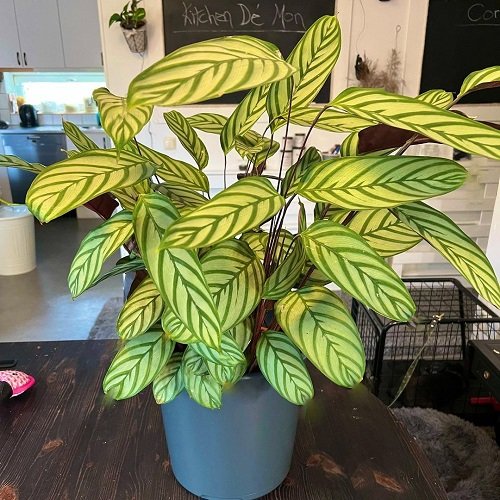Calathea Setosa is a must-have plant in anyone’s collection – thanks to its colorful leaves and ease of maintenance!
Discover expert tips and techniques to maintain the vibrant foliage of Calathea Setosa! It is an eye-catching houseplant you must grow.
Calathea Setosa Plant Information
Calathea Setosa, also known as the Never Never Plant, Compact Star Plant, Zebra Plant, or Prayer Plant, is a tropical native that offers more than just aesthetic appeal. With its air-purifying properties, it becomes a valuable addition to any indoor setting.
Reaching a height of 15-28 inches (40-70 cm). Its evergreen nature boasts large, broad leaves with beautiful bicolored and variegated patterns—silver with dark green veins on the upper side and a touch of purple underneath.
In a fascinating natural display, the leaves of Calathea Setosa exhibit nyctinasty, closing at night and gracefully reopening in the morning, reminiscent of palms pressed together in prayer.
Here is our How to Grow Calathea Roseopicta Indoors guide
Propagating Calathea Setosa
For optimal propagation of Calathea Setosa, the recommended method is division during repotting in the spring season.
- To divide Calathea Setosa, begin by identifying the natural divisions in the rootball, gently separating the roots at these points using your fingers.
- Take care not to break the roots. Trim off any damaged or diseased roots and divide the plant into two unless it is sufficiently large to create additional divisions.
- Place each division’s roots into new pots, filling them with soil up to the same level as the original plant.
- To minimize stress, consider using some soil from the mother plant. After planting, water thoroughly and allow any excess water to drain.
- For a greenhouse-like environment, cover the divisions with a clear plastic bag until new growth appears, helping to retain heat and humidity.
- Once new growth emerges, remove the plastic bag and continue caring for your Calathea Setosa divisions as you would the original plant.
Check 45 Fussy But Fabulous Calatheas You Need To See
Requirements for Growing Calathea Setosa

Light
Calathea Setosa is not tolerant of direct sunlight and thrives best in filtered or partial sunlight. Positioning it near a south-facing window provides a good balance of sunlight.
Excessive sunlight can fade the foliage’s beauty, while very low light can cause the leaf variegation to diminish. Careful placement ensures Calathea Setosa‘s stunning foliage remains vibrant and visually appealing.
Soil
Calathea Setosa prefers a well-draining potting mix to prevent waterlogging and root rot. You can start with a base of regular indoor potting soil or a mixture of equal parts peat moss, perlite, and vermiculite.
Here are the best recipes to make the perfect growing medium for your plants
These components ensure proper drainage while retaining adequate moisture. Adding a small amount of well-rotted compost or leaf mold can provide additional nutrients and improve the overall structure of the potting mix.
Water
To maintain healthy growth, it is important to keep the soil of Calathea Setosa moist but avoid over-saturation. Watering once a week or when the top layer of soil feels dry is recommended, ensuring each watering is done in small amounts.
During winter, the frequency of watering can be reduced to once every three weeks.
Here are the best ways to water plants
Temperature and Humidity
Similar to their tropical origins, Calathea Setosa thrives best in temperatures ranging from 65°F to 85°F (18°C to 30°C), making it well-suited for typical indoor environments.
Calathea Setosa prefers humidity levels between 50% and 70%. Try to maintain the humidity within this range to mimic its native tropical environment.
Placing the plant’s pot on a tray filled with water and pebbles can help increase humidity around the plant. Ensure that the pot is elevated above the water level so the roots don’t sit in water.
Here are 10 Ways To Increase Humidity For Houseplants That Work
Calathea Setosa Care

Fertilizer
During the peak growing season of spring and summer, feeding your Calathea setosa with a well-balanced liquid fertilizer, such as a 10-10-10, once a month, is recommended.
However, refrain from fertilizing during the winter when the plant’s growth slows down. Signs of over-fertilization include yellow, wilted leaves that eventually drop off.
Find Why Calathea Leaves Turning Brown and Yellow here
Pruning
Maintain a tidy appearance and promote healthy growth of your Calathea setosa by removing brown, yellowing, or damaged leaves.
Regular maintenance of the plant ensures its optimal condition and aesthetic appeal. Remember to sterilize your tools before and after each use for proper hygiene and to prevent the spread of diseases.
Re-potting
Be gentle while repotting Calathea setosa as the process can cause stress to the plant. Although some plants can go for years without repotting, it is recommended to provide fresh soil every 1-2 years.
Note: It is important not to choose a pot that is more than 1 inch larger than the previous container to ensure optimal growth.
Pests and Diseases
Calathea setosa is vulnerable to various pests, including mealybugs, spider mites, thrips, aphids, and whiteflies. If you observe any signs of infestation, take immediate action by treating the plant with neem oil or insecticidal soap.
Click here to learn the Amazing Natural Pesticide Recipe that can Kill any Pest
Additionally, common fungal diseases such as powdery mildew, leaf spot, fungal root decay, and white soil mold can affect the plant.
To prevent fungal diseases, ensure proper watering, sufficient airflow, and suitable temperatures. Address these issues with a suitable fungicide, following the instructions provided on the label. Taking these preventive measures and implementing appropriate treatments will help maintain the health and vitality of your Calathea setosa.



